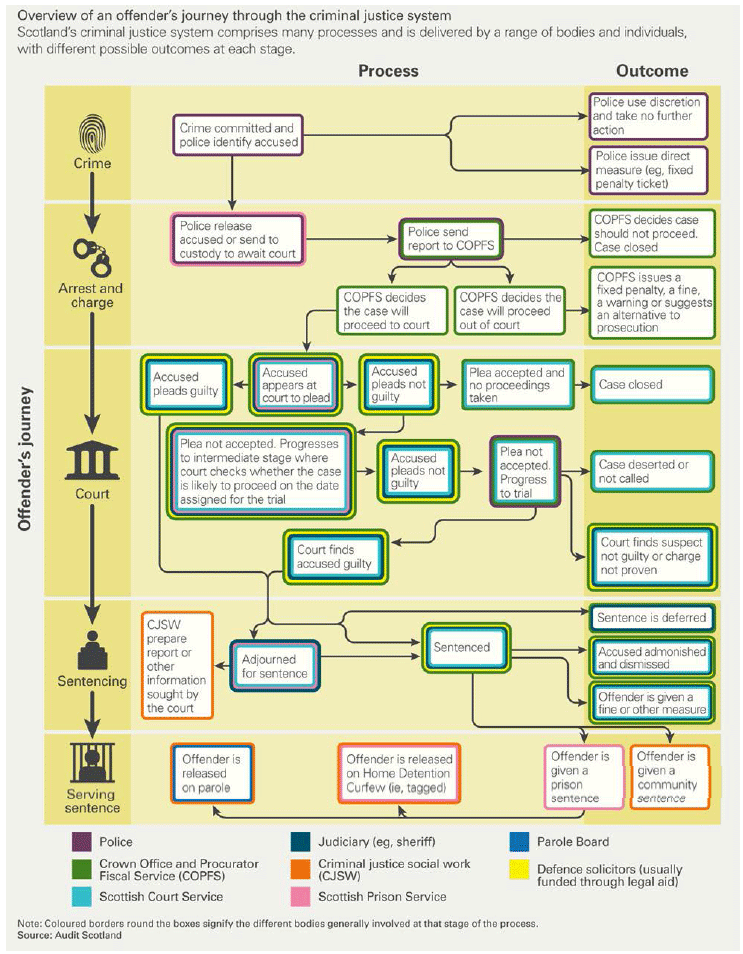Reconviction rates in Scotland: 2013-2014 offender cohort
Scottish Government publication providing analysis of trends in reconviction figures up to the latest cohort of 2013 to 2014.
This document is part of a collection
Background
The Scottish justice system
Recidivism is where someone has received some form of criminal justice sanction (such as a community sentence or a fine) and goes on to commit another offence. Determining recidivism is important, as it illustrates the effectiveness of the criminal justice system on the punishment and rehabilitation of offenders. Reconviction rates are a proxy measure for recidivism, as not all offences committed or recorded by the police will necessarily result in a conviction in court (see Annex A1).
Scotland's criminal justice system offers many different possible outcomes and interventions at each stage of the offender's journey. This system is summarised in the Audit Scotland report ( An Overview of Scotland's criminal justice system) and is shown in Chart 2. Not all offences reported to the police result in a conviction, and reoffending is not the same thing as reconviction as the intervention of the criminal justice system takes place between these two events. Reconviction can be affected by many different variables that are not necessarily related to the incidence of crime (see page 8 of the Criminal Proceedings in Scotland publication).
For the majority of the analyses in this bulletin, we measure the reconvictions of a cohort of offenders within a follow-up period of one year after a conviction. A cohort is defined as all the offenders that are either estimated to have been released from a custodial sentence, or given a non-custodial sentence, in a specified financial year. For example, the 2013-14 cohort is the group of offenders who were released from a custodial sentence, or were given a non-custodial sentence, between the 1 st April 2013 and the 31 st March 2014 (See Annex Table A1 and Annex A5 for definitions and more details). In this bulletin, for clarity, the cohort may be referred to by its year alone.
The "index conviction" is the reference conviction which is determined by either:
(a) the estimated release date for a custodial sentence imposed for the conviction, or
(b) the sentence date for non-custodial sentences imposed for the conviction.
Whichever conviction had the earliest of these dates in a given financial year is defined as the index conviction for an individual offender. The crime which resulted in the index conviction is the "index crime", and the sentence given for the index conviction is the "index disposal". (See Annex Table A1 and Annex A5 for definitions and more details).
Measures of reconviction: the reconviction rate
The reconviction rate is presented as the percentage of offenders in the cohort who were reconvicted one or more times within a specified follow up period from the date of the index conviction. For most analyses in this bulletin, the follow-up period is one year, except for Table 12 where a two year follow up period is presented and for Table 15 and Table 16 where the previous conviction history of offenders over a ten year period is presented. For example, the 2013-14 reconviction rate is 28.3 per cent ( Table 1), and this means that just over a quarter of offenders were reconvicted at least once in the year following their non-custodial conviction or release from a custodial sentence in 2013-14. The definitions in Annex Table A1 provide more details about the terminology used in this publication.
Information presented in this bulletin is derived from the Scottish Offenders Index ( SOI), which is a subset of the Criminal Proceedings in Scotland dataset. The SOI contains all convictions, and the main offence involved was either a crime in Groups 1-5 of the Scottish Government's classification of crimes, or some offences in Group 6. Minor sentences, such as drunkenness and the majority of vehicle offences, are excluded. See Annex B1, Annex B3, and Annex Table A2 for more details.
Measures of reconviction: average number of reconvictions per offender
The reconviction rate provides an indication of progress in tackling overall offender recidivism. This measure, however, may not be sensitive enough to detect individual-level progress as a result of interventions and programmes in the criminal justice system. Such programmes may have been successful in reducing the number of reconvictions, but not complete desistance from crime, by an offender. This bulletin provides a more detailed analysis of reconvictions by also reporting the complementary measure of the average number of reconvictions per offender.
The average number of reconvictions per offender is a measure of the number of times that offenders in a cohort are reconvicted within the follow-up period. It is calculated as the total number of reconviction events of all the offenders in the cohort, divided by the total number of offenders in the cohort. For example, the average number of reconvictions per offender for the 2013-14 cohort over one year is 0.51 ( Table 1), which means that, on average, offenders have about half a reconviction in a one year follow up period. It should be noted that as this measure is an average, there may be variation in the number of reconvictions that individual offenders have: for example any group may include offenders with no reconvictions and some offenders with multiple reconvictions.
In this bulletin we also measure the proportion of people who receive a non-court disposal and who go on to receive another non-court disposal within a year. The cohort for non-court disposals is defined as the group of people who receive a non-court disposal from the police or Crown Office and Procurator Fiscal Service ( COPFS), such as a fine or warning, in a given financial year.
Chart 2: An offender's journey through the criminal justice system.

(Source: Audit Scotland 2011 An overview of Scotland's criminal justice system)
Contact
Email: Mark Bell
Phone: 0300 244 4000 – Central Enquiry Unit
The Scottish Government
St Andrew's House
Regent Road
Edinburgh
EH1 3DG
There is a problem
Thanks for your feedback